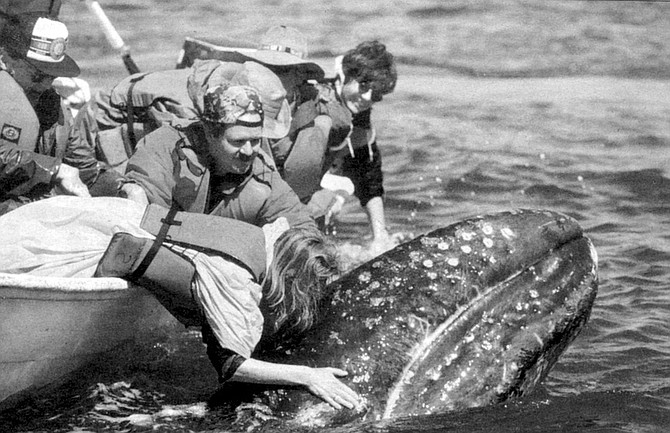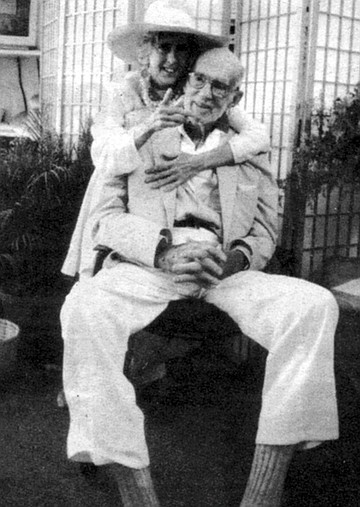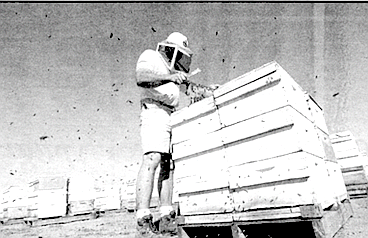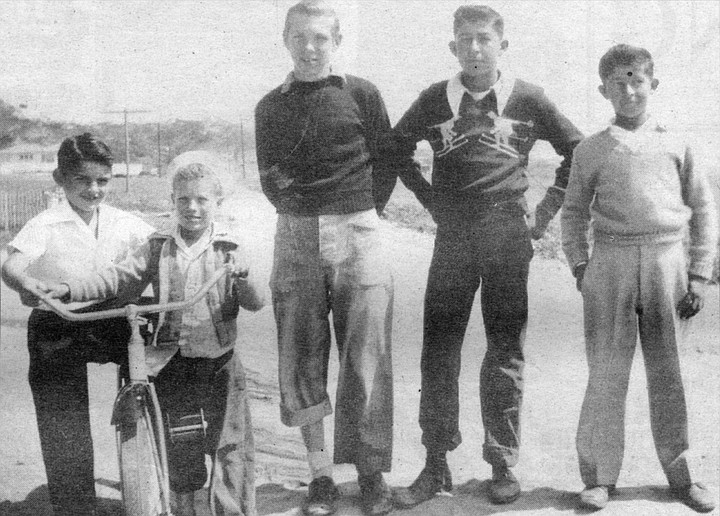
One whale “came right next to the skiff and everyone was rubbing it and petting it.”

Mary Morgan and Dr. Spock, July 1997. She says Deepak Chopra assured her, “If you’ll bring him to San Diego, I know there’ll be people who will help you take care of him.”
- 53-year-old Morgan, Dr. Spock’s second wife, has been relentless and inventive in her search for ways to keep her husband youthful and healthy. For his 75th birthday, for example, when they’d been married for only a year and a half, she gave him lessons in transcendental meditation, and ever since, she and he have meditated twice daily, “even in his darkest hours.”
- By Jeannette DeWyze, Nov. 20, 1997
- He and some of his students were in San Ignacio lagoon collecting samples of the whales’ breath. A whale cow and calf approached their boat and the calf was “friendly as anything; all over the edge of the boat,” Sumich recalls. He says he wanted the students to have the fun of petting the ebullient juvenile. “So I got into the bow, and I leaned back to watch.” After a few moments, Sumich says the mother whale thrust her huge head out of the water in the vertical position known as spyhopping.
- By Jeannette DeWyze, Oct. 23, 1997

Steve Garber fixing a slab. If a building is to be sold, the toilet, installed in 1988, must be replaced with a 1.6-gallon model and the faucet in the bathtub must be above the floodline of the bath to prevent “gray” water being siphoned back into the potable water supply.
Photo by Sandy Huffaker, Jr.
- Steve started plumbing for his father at 13 but then spent much of the next 25 years trying to get out of the business. At first he wanted to be a veterinarian, then changed his mind and graduated from UC Santa Cruz as a biology major with a hefty subspecialty in reading literature and writing poetry. Almost at once his father gave him an ultimatum: take over the family business or I’ll sell it.
- By Tim Brookes, June 26, 1997
- Included in the documents provided by Mexican authorities are stories of the gang's bloody odyssey from those alleged to have had an inside view, including a man known as el Cocinero, (the cook), who, according to the documents, was the gang’s personal chef during various periods. Pancer says that el Cocinero, whose real name is Fausto Soto Miller, now complains he was tortured by Mexican police.
- By Carlos Bey, Oct. 16, 1997

Body of Ernesto Ibarra Santes in taxi, September 14 1996
- On Yom Kippur, the Day of Atonement, Moe Greenberg puts on his suit jacket without a word and drives to temple for the second time, this time alone. During the morning service, my father felt entitled — between call and response, a lackluster sermon, the unseemly organ music of our Reform congregation — to sneak outside the sanctuary for a cigarette, wander around the lobby peering at memorial plaques and tributes that mocked his efforts.
- By Sue Greenberg, Oct. 9, 1997

My visits to Moe’s grave site are a solitary ritual reserved for anniversaries and birthdays.
- "The guarantee creates this perverse economic relationship in which the Chargers can continue to raise ticket prices as they claim they need more and more money to pay football players higher and higher salaries and because they have, you know, more and more corporate jets to fly their executives around the country because they’re engaged in all these big-league business deals. They keep raising the prices, and we guarantee them."
- By Matt Potter, Sept. 25, 1997

Bruce Henderson: "I’ve had councilmembers rise up out of their chairs, screaming at me at the top of their voice."
- “I’m picky,” Ramona says. “Like, if I was a supermodel, I’d still think I was fat. I don’t care what I eat or drink. I go to the gym and work out. I run, lift weights (not the big ones, just five-pound and eight-pound). My dad is, like, big, but my mom is really skinny, so I work out because I don’t want to end up like my dad.”
- By Madeline DeFrees, Sept. 18, 1997

Deena, Alice, and Holly. "The voices of the others turn shrill in an unanimous longing for pierced tongues and bellybuttons."
- There was nothing to do but walk back to the house. Eric and his wife walked 10 yards, 20 yards, 30. The sky was still pink in the west. They were halfway home when, in all that silence, in a place where a lizard could be heard from ten yards away, they heard the explosion of a fired gun. A woman screamed inside his father’s house. The gun was racked and fired again. Eric told his wife to run and hide while he went up to the house alone.
- By Laura McNeal, July 17, 1997

Ed III's house at the Borrego Air Ranch. Eric watched his father pace with the gun, waited for a safe moment to enter the house, and discovered the bodies on the kitchen floor.
- As the nationwide manhunt for Andrew Cunanan grinds on, an almost palpable discomfort is growing in the hills of La Jolla. Not only is Cunanan the son of a Prospect Street stockbroker who purportedly swindled thousands of dollars from his clients, but in newspaper accounts from Houston to Minneapolis, the 27-year-old Bishop’s School track star is being linked to some of the village's wealthiest and most influential denizens, both living and dead.
- By Matt Potter, May 22, 1997

The Caliph in Hillcrest is "a gay bar where older men can meet younger men."
- There are about 30,000 beehives in San Diego County, and just now, Alan Mikolich and I are standing amid 140 of them. Mikolich is a commercial beekeeper, one of the dozen or so in San Diego County. For his entire adult working life, from the time he was a teenager, Mikolich has worked with bees — six or seven days a week, 10 to 12 hours a day, year-round — moving beehives. Fixing beehives, taking the honey out of beehives.
- By Douglas Whyknott, May 15, 1997

In San Diego County a hive has to be located 100 feet from a road, 600 feet from a dwelling.
Photo by Sandy Huffaker, Jr.
- Once the crew building Interstate 5 in the early 1960s went home for the day, the kids growing up in Del Mar Terrace had the time of their lives. The Terrace is the area immediately south of Del Mar, a small community nestled into the side of sandstone bluffs above the slough and west of I-5. First the kids scaled the six-foot, heavily treaded tires of the earthmovers, and then they put all their weight behind the enormous gearshifts.
- By Bonnie ZoBell, Feb. 27, 1997

Terrace Rats from left to right: Joe Gooding, Johnny Carter, Larry, Eddie Polloreno, Larry Polloreno. The Terrace Rats had finally met up with their inland counterparts—the ones across the freeway who’d also enjoyed playing on the earthmovers used to build I-5.
- In the spring of 1963 she headed for San Diego County with her sights set on Diegueño (the name by which the Kumeyaay language was then known). By then she had studied the “bits and scraps” that had been written about it: a few short word lists, one tiny article describing the phonetics of the language spoken on the Mesa Grande reservation near Santa Ysabel. “It at least gave me an inkling of the kinds of sounds the language might have.”
- By Jeannette DeWyze, Jan. 30, 1997

From Let's Talk Tiapa Aa. “There is no generic word for ‘rabbit.’ You have a word for a jackrabbit, a cottontail, and a brush rabbit."
Ted Couro & Margaret Langdon
 Facebook
Facebook
 X
X
 Instagram
Instagram
 TikTok
TikTok
 Youtube
Youtube
























